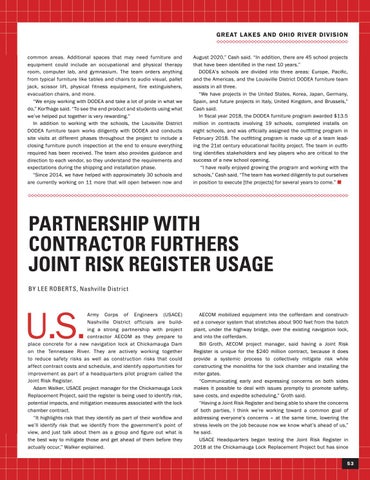GRE AT L AKES AND OHIO RIVER DIVISION
common areas. Additional spaces that may need furniture and equipment could include an occupational and physical therapy room, computer lab, and gymnasium. The team orders anything from typical furniture like tables and chairs to audio visual, pallet jack, scissor lift, physical fitness equipment, fire extinguishers, evacuation chairs, and more. “We enjoy working with DODEA and take a lot of pride in what we do,” Korfhage said. “To see the end product and students using what we’ve helped put together is very rewarding.” In addition to working with the schools, the Louisville District DODEA furniture team works diligently with DODEA and conducts site visits at different phases throughout the project to include a closing furniture punch inspection at the end to ensure everything required has been received. The team also provides guidance and direction to each vendor, so they understand the requirements and expectations during the shipping and installation phase. “Since 2014, we have helped with approximately 30 schools and are currently working on 11 more that will open between now and
August 2020,” Cash said. “In addition, there are 45 school projects that have been identified in the next 10 years.” DODEA’s schools are divided into three areas: Europe, Pacific, and the Americas, and the Louisville District DODEA furniture team assists in all three. “We have projects in the United States, Korea, Japan, Germany, Spain, and future projects in Italy, United Kingdom, and Brussels,” Cash said. In fiscal year 2018, the DODEA furniture program awarded $13.5 million in contracts involving 19 schools, completed installs on eight schools, and was officially assigned the outfitting program in February 2018. The outfitting program is made up of a team leading the 21st century educational facility project. The team in outfitting identifies stakeholders and key players who are critical to the success of a new school opening. “I have really enjoyed growing the program and working with the schools,” Cash said. “The team has worked diligently to put ourselves in position to execute [the projects] for several years to come.” n
PARTNERSHIP WITH CONTRACTOR FURTHERS JOINT RISK REGISTER USAGE BY LEE ROBERTS, Nashville District
U.S.
Army Corps of Engineers (USACE) Nashville District officials are building a strong partnership with project contractor AECOM as they prepare to place concrete for a new navigation lock at Chickamauga Dam on the Tennessee River. They are actively working together to reduce safety risks as well as construction risks that could affect contract costs and schedule, and identify opportunities for improvement as part of a headquarters pilot program called the Joint Risk Register. Adam Walker, USACE project manager for the Chickamauga Lock Replacement Project, said the register is being used to identify risk, potential impacts, and mitigation measures associated with the lock chamber contract. “It highlights risk that they identify as part of their workflow and we’ll identify risk that we identify from the government’s point of view, and just talk about them as a group and figure out what is the best way to mitigate those and get ahead of them before they actually occur,” Walker explained.
AECOM mobilized equipment into the cofferdam and constructed a conveyor system that stretches about 900 feet from the batch plant, under the highway bridge, over the existing navigation lock, and into the cofferdam. Bill Groth, AECOM project manager, said having a Joint Risk Register is unique for the $240 million contract, because it does provide a systemic process to collectively mitigate risk while constructing the monoliths for the lock chamber and installing the miter gates. “Communicating early and expressing concerns on both sides makes it possible to deal with issues promptly to promote safety, save costs, and expedite scheduling,” Groth said. “Having a Joint Risk Register and being able to share the concerns of both parties, I think we’re working toward a common goal of addressing everyone’s concerns – at the same time, lowering the stress levels on the job because now we know what’s ahead of us,” he said. USACE Headquarters began testing the Joint Risk Register in 2018 at the Chickamauga Lock Replacement Project but has since 53





































































